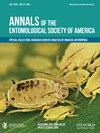In Search of an Honest Butterfly: Sexually Selected Wing Coloration and Reproductive Traits From Wild Populations of the Cabbage White Butterfly
IF 1.8
3区 农林科学
Q1 ENTOMOLOGY
引用次数: 0
Abstract
Abstract Sexual selection is central to many theories on mate selection and individual behavior. Relatively little is known, however, about the impacts that human-induced rapid environmental change are having on secondary sexually selected characteristics. Honest signals function as an indicator of mate quality when there are differences in nutrient acquisition and are thus potentially sensitive to anthropogenically altered nutrient inputs. We used the cabbage white butterfly, Pieris rapae (L.) (Lepidoptera: Pieridae), to investigate differences in color and testes size in a system that is often exposed to agricultural landscapes with nitrogen addition. We collected individuals from four sites in California and Nevada to investigate variation in key traits and the possibility that any relationship between wing color and a reproductive trait (testes size) could vary among locations in the focal butterfly. Coloration variables and testes size were positively albeit weakly associated across sites, consistent with the hypothesis that females could use nitrogen-based coloration in the cabbage white as an indicator for a male mating trait that has the potential to confer elevated mating success in progeny. However, variation in testes size and in the relationship between testes size and wing color suggest complexities that need exploration, including the possibility that the signal is not of equal value in all populations. Thus these results advance our understanding of complex relationships among environmental change and sexual selection in the wild.寻找诚实的蝴蝶——甘蓝白蝶野生种群翅膀颜色和繁殖特性的性选择
摘要性选择是许多择偶和个体行为理论的核心。然而,人们对人类引发的快速环境变化对第二性选择特征的影响知之甚少。当营养获取存在差异时,诚实信号可以作为配偶质量的指标,因此可能对人为改变的营养输入敏感。我们使用卷心菜白蝶,菜粉蝶(鳞翅目:粉蝶科),研究了一个经常暴露在添加氮的农业景观中的系统中颜色和睾丸大小的差异。我们从加利福尼亚州和内华达州的四个地点收集了个体,以调查关键特征的变化,以及翅膀颜色和繁殖特征(睾丸大小)之间的任何关系在斑蝶的不同位置可能不同的可能性。着色变量和睾丸大小在不同位点之间呈正相关,尽管相关性较弱,这与雌性可以使用甘蓝白中基于氮的着色作为雄性交配特征的指标的假设一致,该交配特征有可能提高后代的交配成功率。然而,睾丸大小的变化以及睾丸大小和翅膀颜色之间的关系表明了需要探索的复杂性,包括信号在所有群体中的价值不相等的可能性。因此,这些结果促进了我们对环境变化和野外性别选择之间复杂关系的理解。
本文章由计算机程序翻译,如有差异,请以英文原文为准。
求助全文
约1分钟内获得全文
求助全文
来源期刊
CiteScore
4.90
自引率
0.00%
发文量
25
审稿时长
6-12 weeks
期刊介绍:
The Annals of the Entomological Society of America exists to stimulate interdisciplinary dialogue across the entomological disciplines and to advance cooperative interaction among diverse groups of entomologists. It seeks to attract and publish cutting-edge research, reviews, collections of articles on a common topic of broad interest, and discussion of topics with national or international importance. We especially welcome articles covering developing areas of research, controversial issues or debate, and topics of importance to society. Manuscripts that are primarily reports of new species, methodology, pest management, or the biology of single species generally will be referred to other journals of the ESA. The most important criteria for acceptance are quality of work and breadth of interest to the readership.

 求助内容:
求助内容: 应助结果提醒方式:
应助结果提醒方式:


